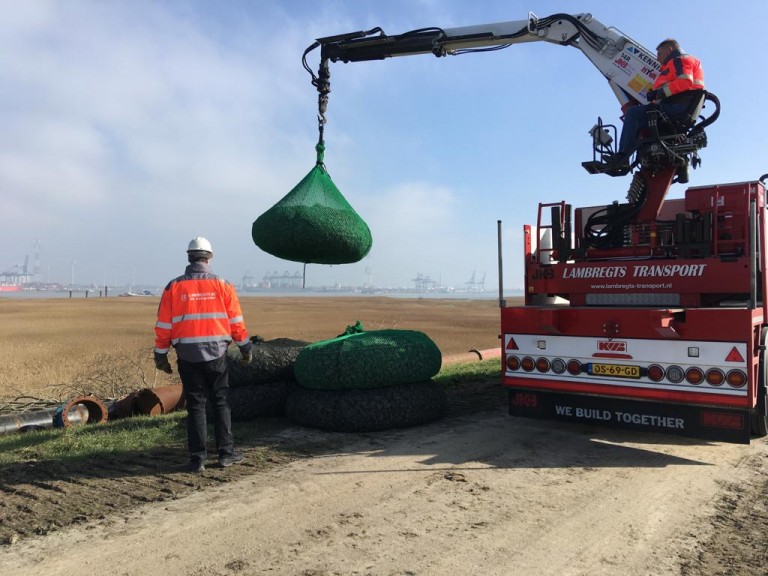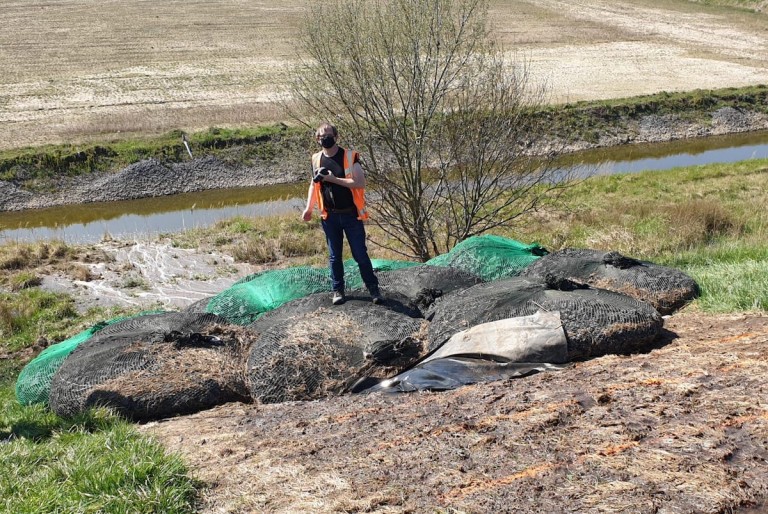Repairing levee damage with rock bags
- 27 April 2021
- Francien Horrevorts
- Emergency Response
For the very first time we used rock bags to repair levee damage in the Living Lab Hedwige-Prosperpolder. We also tested the repair measure with intense water overflow. Curious to learn what rock bags are and how our first experiment went? Keep reading!
Rock bags
Using rock bags to repair levee damage is quite a new technique. Rock bags are flexible nets filled with rocks or riprap that can be used to manage and protect against erosion. They are for instance used near railways, rivers and foreshores. It is a flexible protection measure that is easy to use and requires little manpower.

Why Rock bags?
Our partner in the UK, the Environment Agency, proposed to use this technique in the Living Lab. Faye Lynch explains: “The Environment Agency has been trying this new measure out in several places in the UK for emergency embankment repair. We learned from our colleagues that it is quick and easy to install in case of an emergency. We wanted to test things like the rock bags’ robustness, time to install, plus any additional learning that we could share back with our Environment Agency colleagues and Polder2C’s partners.”
New circumstances
The damage and levee differed from the case studies that Faye Lynch researched. “They were used for larger levee damages across the stretch of the face of the slope. And so the size and shape of the damage was different. Also, for Polder2C’s the rock bags were already filled by the contractor and no granular material was laid down under the rock bags.” says Faye.
The experiment
Mark Postma, Rijkswaterstaat, was part of the crew to execute the repair measure on the inner slope of a levee. Mark: “We were impressed how fast we were able to install the bags. After some ground preparations, we had a crane lifting the bags into the damage. The first bottom layer needed the most attention and had to be placed very accurately. In total we used 33 rock bags of 2000 kg each. We did have some problems blending the rock bags into the slope of the levee. So, they formed a kind of bump on the levee which was not the intention. Other than that, it went well and we learned a lot.”
"It was a fast and robust technique and we learned a lot from the experiment."
Mark Postma
Overflow tests
A couple of weeks after repairing the levee damage, our colleagues went back to the polder and tested how well the rock bags would hold during overflow tests. Bart Vonk, Rijkswaterstaat, present at the overflow tests, explains: “The transitions of the rock bags and grass cover were one of the weak points of the repair. Already after 30 seconds of the first test run of the overflow generator we discovered large holes on these transitions and under the rock bags. We closed them with sandbags and geotextile to prevent a bad start during the real tests.”
However, the next day, half an hour into the overflow tests, the sand started to erode from under the rock bags. Also, the higher placed rock bags started to collide into the ground. “We decided that the risk for progressive erosion undermining the levee was too high and we stopped the overflow tests. It seems that placing rock bags on a sand core without a filter in between leads to sand transport from the core of the levee by water overflow. We have seen the rock bags deforming into the ground as evidence.” states Bart.

Learnings
There are some things that could be concluded from the experiment:
- The bags seemed to be a bit over-filled, which caused them to be less flexible so it was more difficult to have them take on the shape of the slope.
- Some experience is necessary for placing the rock bags correctly and preparing the soil.
- This is not the preferred solution for the inner slope. This measure seems more suitable for damages on the outer slope of the levee or in case of breaching or as counter weight in in case of macro stability or heave issues. For the micro stability damage in the inner slope clay or geotextile with sandbags are proven and preferred techniques.
- It appears that the lack of a (granular) filter under the rock bags may have caused unwanted erosion of the sand from under the rock bags following overflow tests leading to deformation of the levee and initial start of total failure.
Further research
The experiment asks for further research. Mark: “It was very useful to try out this technique, we already learned a lot. We think this is not the best solution for the inner slope, but we recommend trying out this technique in case of breaching or on the outer slope of the levee. Also, in our case the nets were made out of plastic. It would be highly preferable to use an environment friendly alternative. At this point we are not sure whether we can include these experiments in the Polder2C’s project. But we will definitely keep it in mind if an opportunity arises.”
Stay up to date
Want to keep up to date of our next activities? Follow us on LinkedIn, Twitter and subscribe for our newsletter.
